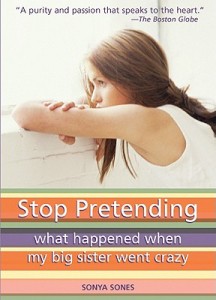 Sones, Sonya. (1999) Stop Pretending: What Happened When My Big Sister Went Crazy. New York, NY: HarperCollins
Sones, Sonya. (1999) Stop Pretending: What Happened When My Big Sister Went Crazy. New York, NY: HarperCollins
Plot Summary:
When Cookie’s sister suffers from a mental breakdown and is sent to a hospital to recover, Cookie deals with her confusion, pain, and loss the way so many other 13 year olds do – by writing poems. Starting from the night of her sister’s breakdown and ending with signs of recovery, Cookie chronicles the heartbreak and confusion of a family torn apart by mental illness.
Critical Evaluation:
Stop Pretending is the kind of story that is meant to be told in verse, for poetry is exactly the kind of creative outlet that a teen girl would turn to in an effort to deal with and make sense of the heartache of losing her sister to madness. While each poem helps to move the story along, every single one could also stand alone and feels like it would be the kind of poem a teen would write. (Readers will be unsurprised to learn that the story and poems are based on Sones’ own family’s experiences.) None of the verse feels forced or warped in an effort to include important plot points. Stop Pretending is crushingly beautiful and, like all good young adult books, ends on a sad but hopeful note that offers solace and understanding.
Reader’s Annotation:
When Cookie’s sister suffers from a mental breakdown and is sent to a hospital to recover, Cookie deals with her confusion, pain, and loss the way so many other 13 year olds do – by writing poems.
Author Information:
http://www.facebook.com/pages/Sonya-Sones/175441839174257
@SonyaSones
Genre:
Realistic Fiction
Booktalking Ideas:
Because the format is such a large part of the story, it would be important to incorporate into the booktalk use of the poetry.
Potential Controversy:
While some of Sones other books are often challenged because of their sexual content, Stop Pretending seems to mostly fly under the radar. There is frank discussions of mental illness and the typical teen angst and anger at her parents and sister.
Reasons for Choosing This Title:
I have to admit I picked this up in part because I thought it would merely be a quick read. I was pleasantly surprised by how good it was.








